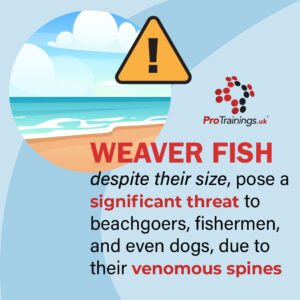Weaver Fish in British Waters: A Hidden Danger
Weaver fish are small, elusive fish commonly found in British coastal waters, particularly during the warmer months of late spring to early autumn. These fish, despite their size, pose a significant threat to
beachgoers, fishermen, and even dogs, due to their venomous spines.
Where and When Are They a Problem?
Weaver fish typically inhabit shallow waters, often burying themselves in sandy or muddy seabeds close to the shore. This makes them a hazard in popular bathing and paddling areas, especially during the summer when the beaches are crowded. The risk of encountering a weaver fish increases during low tide when the water recedes, leaving them exposed and more likely to be stepped on by unsuspecting swimmers or waders.
First Aid for Weaver Fish Stings
If stung by a weaver fish, the pain is immediate and intense, often described as a sharp, burning sensation that can spread from the sting site. The venom can cause swelling, redness, and in some cases, more severe symptoms like dizziness, nausea, or breathing difficulties.
First aid for a weaver fish sting includes:
- Hot Water Treatment: The affected area should be immersed in hot water (not scalding) for 30-90 minutes. The heat helps to neutralise the venom, reducing pain and swelling. Ensure the water is as hot as the person can tolerate without causing burns.
- Pain Relief: Over-the-counter painkillers such as ibuprofen or paracetamol can help manage the pain.
- Wound Care: After soaking, clean the wound thoroughly and apply an antiseptic to prevent infection. Seek medical advice if symptoms persist or worsen.
How to Avoid Injury
Preventing a weaver fish sting is largely a matter of awareness and precaution:
- Footwear: Wearing sturdy water shoes or sandals when walking in shallow waters can provide a barrier against the fish’s spines.
- Shuffling: When walking in the water, shuffle your feet rather than stepping normally. This motion can scare the fish away before you step on them.
- Awareness: Be cautious in areas where weaver fish are known to inhabit, particularly during low tide and in sandy or muddy bottoms.
Can Dogs Be Affected?
Yes, dogs can also be stung by weaver fish, particularly if they enjoy playing in the shallows or digging in the sand. The symptoms in dogs are similar to those in humans, including pain, swelling, and distress. If your dog is stung, it’s essential to apply the same first aid principles: immersing the affected area in warm water and seeking veterinary care promptly.
In conclusion, while weaver fish are a hidden danger in British waters, awareness and simple precautions can help avoid painful encounters for both humans and their canine companions.

